Off the northeast coast of England sits a cluster of 15-20 ancient rock islands with some unusual inhabitants. The Farne Islands are a captivating wildlife refuge for over 200,000 seabirds and a colony of 5,000 grey seals. This ornithological paradise is a popular haunt for one of nature’s most interesting (and adorable) birds — the puffin. When the season is right, tourists can witness these whimsical birds (that resemble a cross between a penguin and a toucan) in their natural habitat. There, more than 35,000 breeding pairs congregate, nest, and raise new young annually.
Accompany us on a journey of exploration into this mysterious, remote, and beautiful place, which is touted as one of the premier destinations for birdwatchers and ocean animal lovers in the entire world.
What Are the Farne Islands?
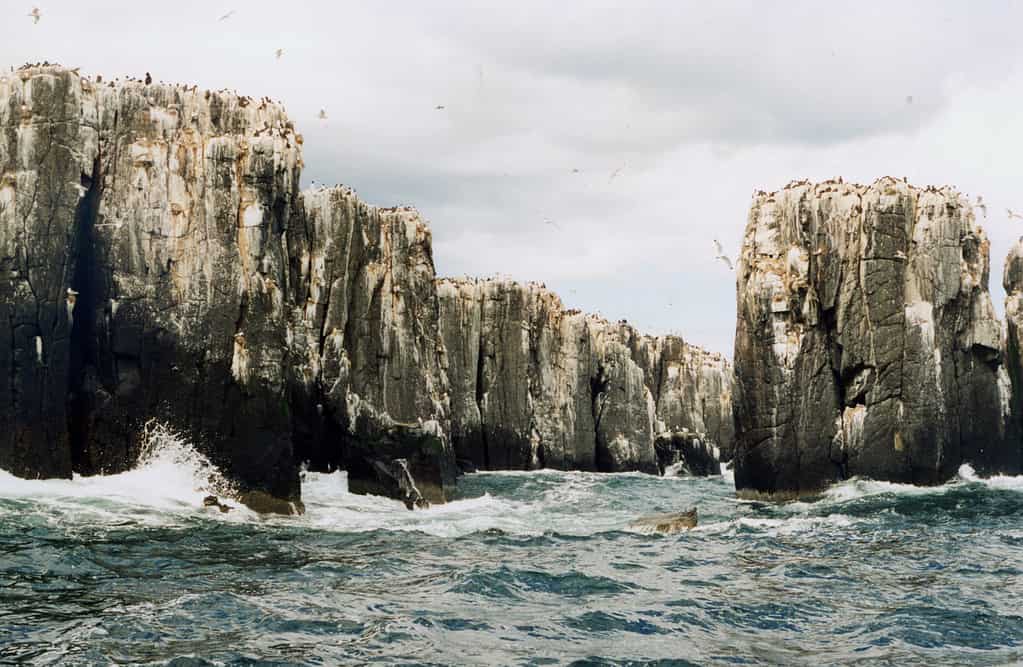
The Farne Islands are composed of towering quartz-dolerite and quartz-microgabbro.
©Vanellus Foto / CC BY-SA 3.0 – License
The Farne Islands are an archipelago with an interesting geological history. They can look dark and imposing from a distance, made up of a combination of towering quartz-dolerite and quartz-microgabbro. These islands, which are part of the Whin Sill complex, were once connected to the mainland and date back 301-294 million years. When cracks in the Earth’s crust developed due to shifting tectonic plates, magma seeped through. That then cooled and crystallized over time, resulting in the sill. Following the conclusion of the Ice Age over 10,000 years ago, rising sea levels eroded the limestone between the mainland and the igneous rock, leaving behind these unique islands.
There are two groups in this mysterious archipelago–the Inner Group and the Outer Group–which are separated by Staple Sound. The prominent islands in the Inner Group include Knoxes Reef, the East and West Wideopens, the Inner Farne, and the Megstone. When the tide is out, all the islands except the Megstone are joined together. The Outer Group’s main islands are North and South Wamses, Big Harcar, Staple Island, Brownsman, and Longstone.
Where Are the Farne Islands Located?
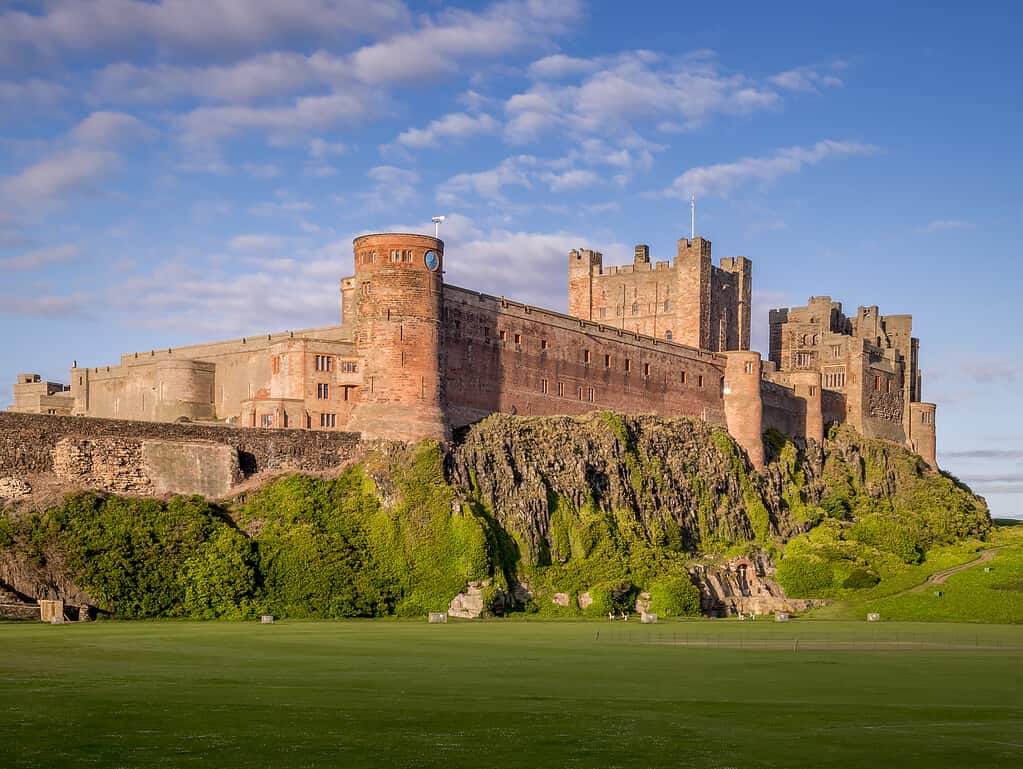
Bamburgh Castle is on the northeast coast of England, in Northumberland, within view of the Farne Islands.
©Matthew Hartley / CC BY-SA 2.0 – License
From 2 to 5 miles off the coast of Northumberland, England, this group of islets (whose numbers shift from 15 to 28 depending on the tides) sits in the frigid North Sea. The nearest coastal town to this popular destination is the picturesque fishing village of Seahouses. Seahouses is famous for its proximity to the imposing Bamburgh Castle (which the 2023 Indiana Jones and the Dial of Destiny features); its quaint, colorful harbor; gorgeous beaches; maritime history; and its fishing, which in modern times results in some of the best fish and chips you’ll ever have the pleasure of tasting!
Seahouses is also the gateway to the Farne Islands, which an average of 45,000 travelers visit yearly. There are booths all around the harbor to accommodate spontaneous tourists. In fact, you can book boat trips to circle and even walk upon these extraordinary islands resplendent with wildlife.
History of the Farne Islands

Pictured is Longstone Lighthouse of the Farnes. It’s the site of an 1838 shipwreck. That wreck made Grace Darling, the lighthouse keeper’s daughter, a hero for saving nine lives.
©Mick Knapton / CC BY-SA 3.0 – License
Human history on these rough, raw islets begins in the 7th century. Then, Irish monks, the Culdees, built small stone structures utilized as hermitages. Interestingly, following the first recorded Culdee resident, Saint Aidan, Saint Cuthbert instituted what many believe to be the earliest bird-protection laws in human history. They included protection for eider ducks and some of the other varieties living on the islands at that time.
Hermits had a continued presence there until 1246 when the last, Saint Bartholomew of Farne, passed away. Varied persons inhabited the islands in times that followed. The ownership of the islands passed from County Durham to the Archdeacon of Durham Charles Thorp (1861) to the industrialist William Armstrong (1894), and most recently, the National Trust.
The National Trust has deemed the Farne Islands a protected nature reserve. It strives to preserve the delicate ecosystem of the islands as a vital breeding ground for 22 different bird species, as well as a popular spot for another 160 migrating species.
You can’t visit the Farne Islands without hearing the story of Grace Darling. The daughter of William Darling, the Longstone lighthouse keeper, she aided him in rescuing nine people from the wreckage of the ship Forfashire on September 7, 1838. The story made news around Great Britain, and Grace Darling became known as a heroine. The Longstone Lighthouse, along with the Inner Farne Lighthouse and Staple Island Lighthouse, are still standing today, and are popular attractions for visitors.
Farne Islands Birds
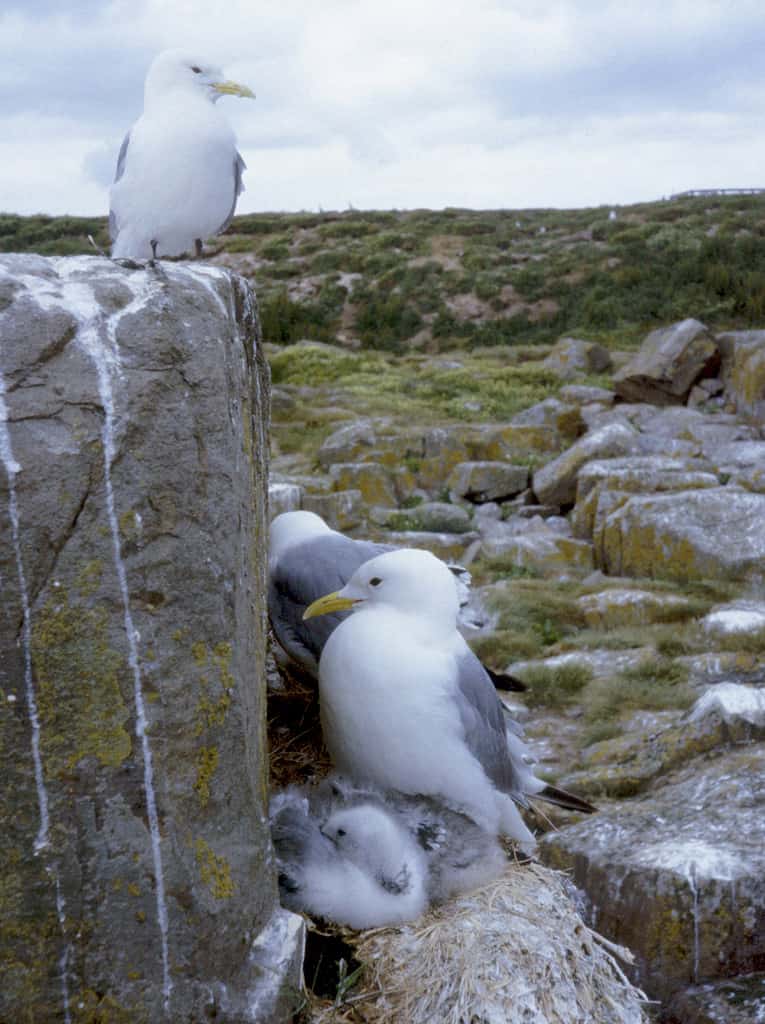
Black-legged kittiwakes are one species of seabirds that breed in the Farne Islands.
©MPF / CC BY-SA 3.0 – License
The Farne Islands are a haven for birdwatchers, with a total of over 200,000 seabirds traveling to the islands annually. Other species have established permanent colonies there. In summer months, the islands are populated by puffins, eider ducks, fulmars, razorbills, shags, guillemots, kittiwakes, common terns, Arctic terns, and Sandwich terns. These birds breed during this time, including the aggressive Arctic terns, who will actually dive-bomb unsuspecting visitors. Hats are strongly advised by tour guides to protect you from bloody wounds.
Most of the bird species depart back to sea in the fall and winter, but some random stragglers remain including shags. The main showstopper of fall is witnessing the massive grey seal colony. Let’s take a closer look at some of the unique bird and animal species that call the Farne Islands home for at least part of the year.
Puffins (Fratercula arctica)

Around 40,000 puffins nest in burrows on the numerous islets of the Farne Islands.
©bzzup/ via Getty Images
Puffins are undeniably the featured attraction of the Farne Islands. Their striking black and white plumage resembles that of a penguin, while their bright orange beaks and webbed feet make them stand out in the multitudes of seabirds they mix with. Close to 40,000 puffins come to the Farne Islands each year to breed, making this location one of the UK’s most significant puffin colonies. Puffin pairs create burrows in the dirt and grassy areas to procreate.
For eager tourists dying for a glimpse of these peculiar birds, they inhabit the islands from late April to mid-July. As babies hatch, sightseers can witness parents fishing in the ocean waters and returning to their burrows with silvery fish to feed their hungry chicks. Fish that puffins feed on in the North Sea include sand eels, herring, and other small fish.
Arctic Terns (Sterna paradisaea)
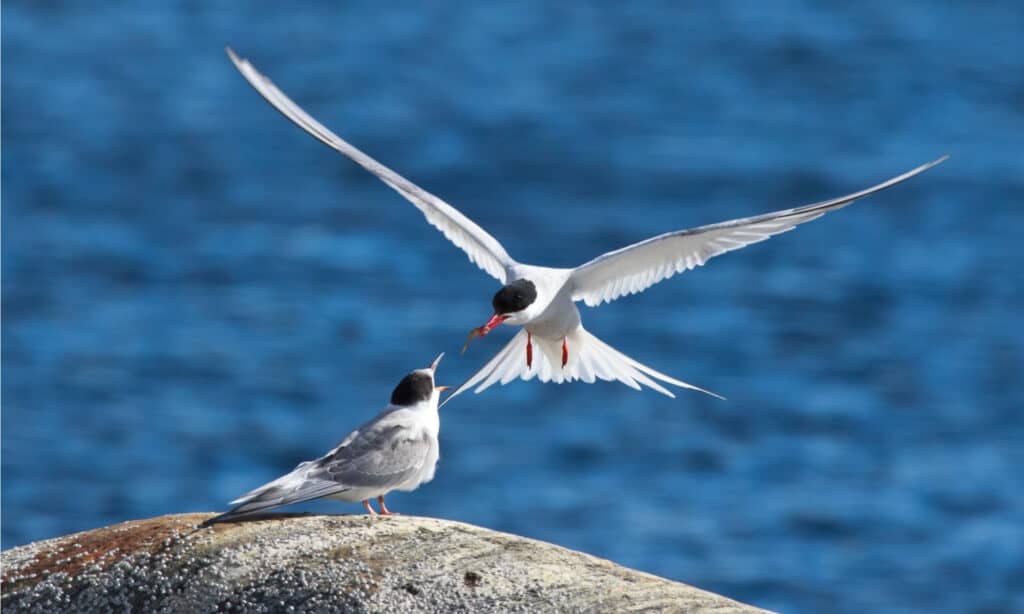
Adult arctic terns are very protective of their nests, and may even attack people who venture too close.
©Monticola/Shutterstock.com
Arctic terns are known for making one of the longest migrations of any bird species on the planet. In fact, they travel up to 44,000 miles per year. They arrive in the Farne Islands in May, numbering up to 20,000, and depart with their young in August for warmer climates like Australia.
By the beginning of June, most of the terns have built nests on the islands, preferring areas with patches of vegetation for their chicks to hide in along grassy clifftops. Arctic terns are infamously hostile when it comes to defending their nests and young. They will make clicking noises while flying up, and are prone to attack perceived predators from above–even humans! Visitors to the island are warned to wear hats or hoods…and if neither is available, waving your arms above your head is highly advised.
Razorbills (Alca torda)
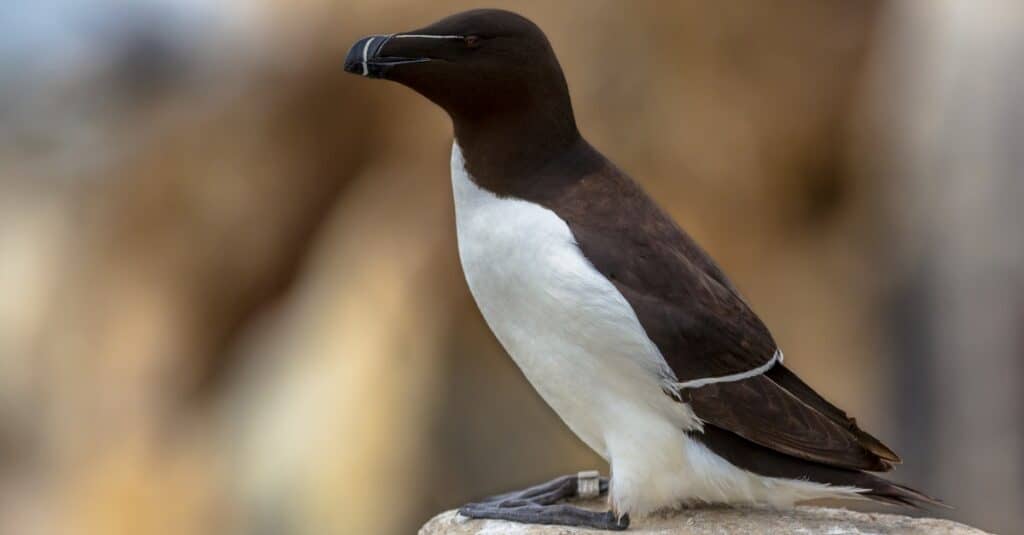
Razorbills, like puffins, have characteristics that resemble penguins.
©iStock.com/CreativeNature_nl
Another group of seabirds that build breeding colonies in the Farne Islands are razorbills. Their tuxedo-like plumage of black top feathers and snow-white underbellies makes them another avian species that resembles the penguin. Like puffins, razorbills also have distinctive beaks, although theirs are black in color with a few thin white streaks–not the vibrant orange dressing of the puffin’s beak.
These birds arrive earlier than some species–late March to be exact, and they remain through July. Their residence of choice for breeding is rocky ledges and steep cliffs. Razorbills demonstrate agile diving skills, fetching herring, sand eels, and a variety of other small fish for themselves or their young.
Guillemots (Uria aalge)
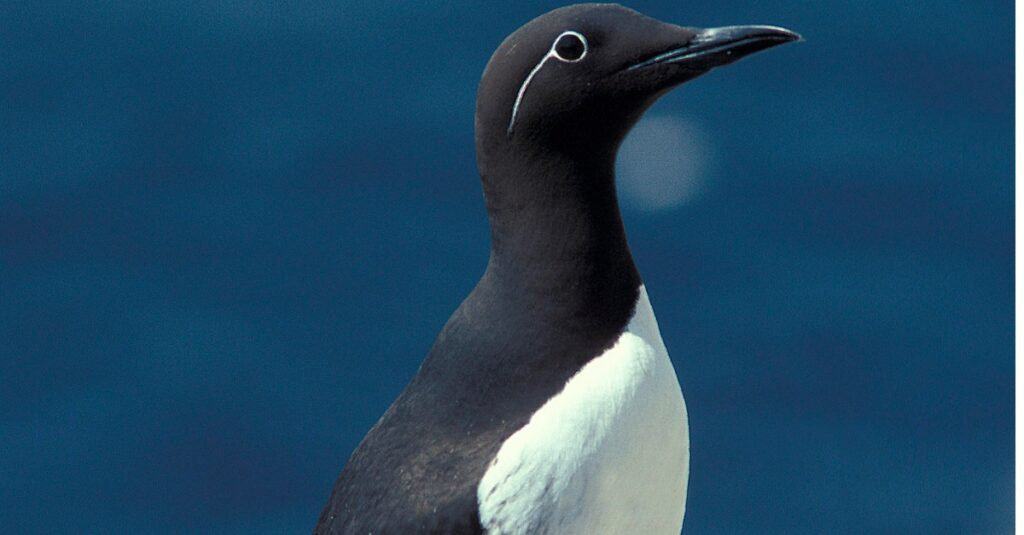
The common guillemot, or common murre, has a French name that is derived from “Guillaume,” meaning William.
©iStock.com/slowmotiongli
Guillemots are in the same family as puffins (auk family) but differ in one distinct way. Puffins and other members of the auk family only lay one single egg at a time. Guillemots, however, lay two eggs. They enjoy laying their eggs out in the open, right at the edge of steep ledges. The location suits them well, as they like to cliff-dive for fish.
Graceful in flight, but noisily vocal, Guillemots are yet another bird that has similar coloring to the penguin–the tuxedo. They only stop on islands like the Farnes for nesting from April to late July. Otherwise, they spend the rest of the year out at sea.
Shags (Phalacrocorax aristotelis)
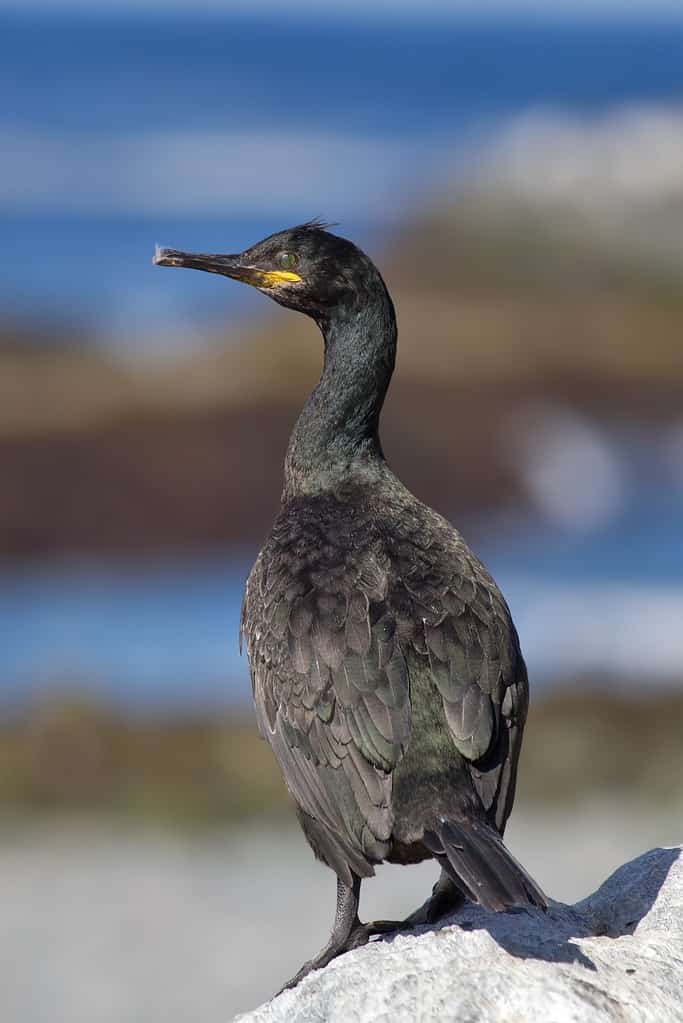
The shag can be seen in the Farne Islands year round.
©Andreas Trepte / CC BY-SA 2.5 – License
Shags could be called deep-sea divers. They are fully capable of diving as deep as 150 feet below the ocean’s surface to scoop up crustaceans, or mollusks in their long, hook-tipped bills. Their plumage is dark and glossy, but their stand-out feature is their piercing emerald green eyes.
These seabirds are year-long residents of the Farne Islands and will raise chicks throughout the year in nests built into rocky crevices.
Fulmars (Fulmarus glacialis)
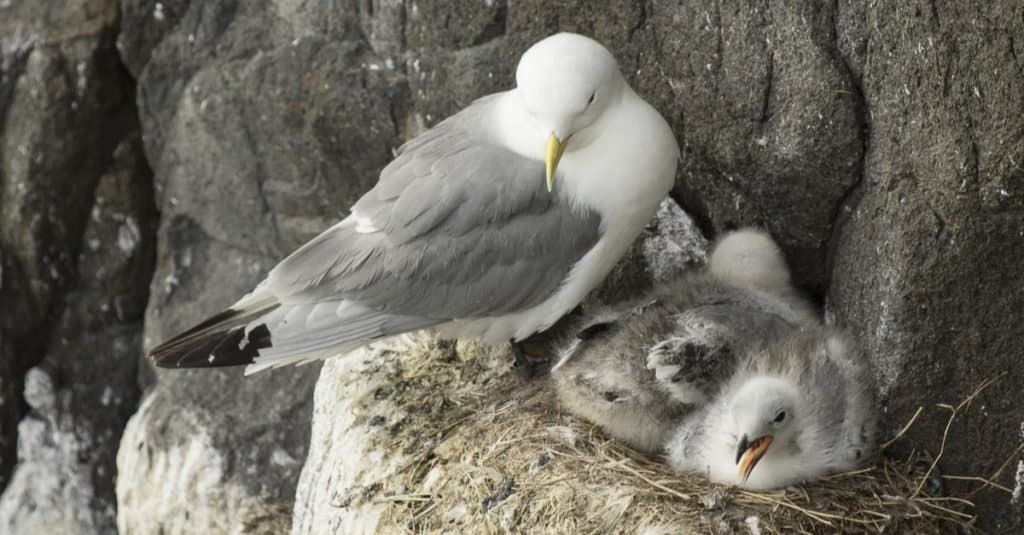
The fulmar prefers nesting in crevices of cliffs. They brave storms and rough weather when other sea birds might seek refuge.
©MichaelY/Shutterstock.com
If it wasn’t for their tube-like noses and stiff-winged flight, fulmars could easily be mistaken for seagulls. The specialized beak is a practical tool to help the fulmar dispel the excess salt it ingests from the fish, shrimp, and squid it feeds on.
While Fulmars aren’t as graceful as gulls, they do enjoy riding drafts of wind straight up the tall cliff faces. They nest in the cliffs and are actually year-round residents of the Farne Islands. Fulmars can live up to 40 years–a long life for a seabird!
Other Animals in the Farne Islands
While it’s obvious that the Farne Islands have birds coming out the wazoo, there is an abundance of other captivating marine animals that reside in this magical place.
Grey Seals (Halichoerus grypus)

Grey seal pups have white fur to help them absorb the sunshine to keep warm.
Besides the puffins, the other big draw to the Farne Islands is the enormous grey seal colony, numbering 5,000 on average. The colony migrates to the islands from September to November. During this time, they breed and give birth to adorable seal pups. Fun fact: the waters around the United Kingdom as a whole contain 40% of the entire world’s population of grey seals!
Whether playing in the water or lounging on flat rock surfaces on the islands, the grey seals are the main autumn attraction for sightseers. Coloring distinguishes males from females. Males are black with gray spots, while females are the opposite–gray with black spots. The pups have white fur that aids in their absorption of sunlight, helping them stay warm while they mature. These animals can reach a max length of 10 feet and weigh up to 880 pounds in adulthood. They have a lifespan of 25 to 35 years.
Whales

Lucky visitors to the Farne Islands may catch a glimpse of a whale, like this
minke whale
.
©Tim Watters/Shutterstock.com
The cold North Sea surrounding the Farne Islands is an occasional destination for whales, including humpbacks, orcas, and minke whales. Migrating through the North Sea during specific times of the year, these gentle giants provide a captivating sight for lucky visitors. There are boat tours specifically focused on whale sightings that depart from Seahouses.
Dolphins and Porpoises
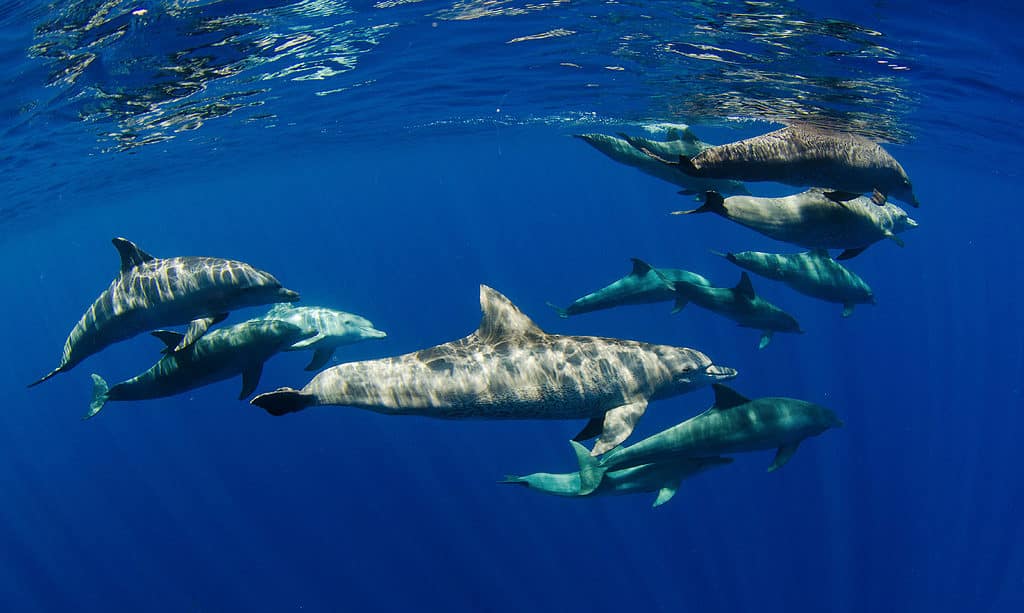
Bottlenose dolphins frequent the North Sea, which is abundant in marine wildlife.
©Joost van Uffelen/Shutterstock.com
Harbor porpoises, bottlenose dolphins, common dolphins, white-beaked dolphins, and even basking sharks have all been seen around the Farne Islands. You can best spy them from the vantage of the many boats that take folks out to the islands to enjoy the region’s rich biodiversity.
Predators

The
peregrine falcon
is one of the few predators that raids nests in bird colonies for eggs or chicks.
©Harry Collins Photography/Shutterstock.com
Fortunately, the seabirds on the Farne Islands don’t have many predators to contend with. That’s due to the remoteness of the island and the fact that only birds and seals inhabit it. Occasionally, large birds of prey like peregrine falcons or herring gulls can pose a threat by feeding on the eggs or young chicks.
Tourism to the Farne Islands
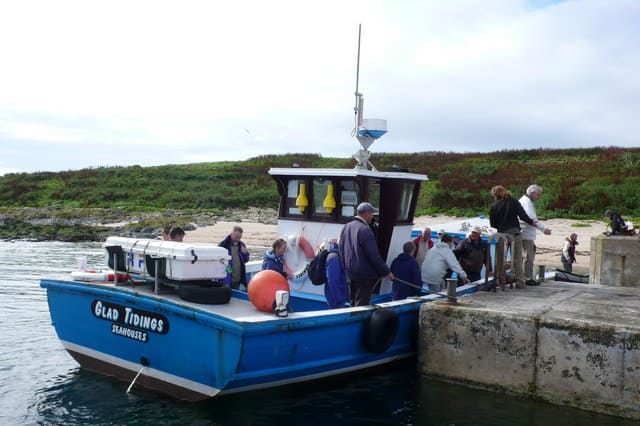
Tourists board a boat to tour the Farne Islands.
©
Boat tours around the Farne Islands attract thousands of wildlife enthusiasts and bird watchers annually. These tours depart from Seahouses and trip options vary. Some only circle the islands. Others, though, will drop tourists off on certain islands to view the lighthouses and other historical buildings. These tours vary in price from $20 up to $50 per person, based on the type of tour and duration. Most last from 2-3 hours.
My Experience
The Farne Islands are near and dear to my heart. From the time I first saw them featured on the PBS show Nature when I was in high school, I had a dream to one day visit and see puffins for myself. That dream became a reality ten years later when my family came to reside in Suffolk, England, for five years. I implored my parents that we travel to the Farne Islands, still clinging to my dream.
We finally journeyed to Seahouses, walked around the very harbor where boats depart daily for the islands, and took a tour through Billy Shiel’s Boat Trips. The sky was cloudy and gray that day, the wind cold, and the water a bit choppy, but our 3-hour boat ride yielded sightings of all the birds I’d heard about in that documentary: puffins, kittiwakes, shags, fulmars, cormorants, Arctic terns, and other varieties of gorgeous seabirds.
From what I can remember, it was fall. We did see puffins, though they weren’t as numerous as they could have been. But the ones I saw….Oh! My heart was fluttering with utter joy! And we also got to see grey seals, piling themselves onto large rock slabs, or poking their heads out of the water to watch us pass by. What a delight!
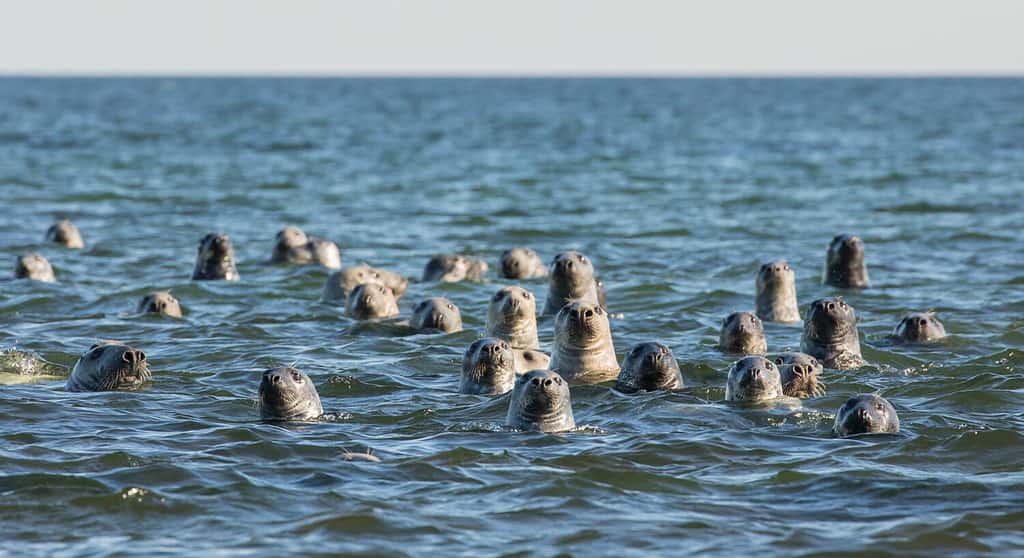
You can see grey seals in the Farne Islands during the autumn months.
©F-Focus by Mati Kose/Shutterstock.com
Our tour allowed for a stop and leisurely walk on Staple Island. The Arctic terns did not disappoint. Like the Alfred Hitchcock movie The Birds, they dove at our heads. We ran down the paths past them as they screeched at us, waving our arms above our heads to ward off an attack. Up ahead of me on the path, a bald man with an uncovered head had a gash in his head with blood trickling down.
Were we scared? No way. We were thrilled! It was an unforgettable experience and one that I am so thankful to have had.
In Conclusion
The Farne Islands offer an unparalleled experience for wildlife enthusiasts. These remote, awe-inspiring islets are the perfect destination to witness the majesty of North Atlantic seabirds in their natural environment or catch a view of lovable grey seals sunbathing on the ancient igneous rocks. If you are passionate about seabirds and wildlife, you may want to put a visit to the Farne Islands on your bucket list.
The photo featured at the top of this post is © Pontificalibus / CC BY-SA 3.0 – License / Original
Thank you for reading! Have some feedback for us? Contact the AZ Animals editorial team.






